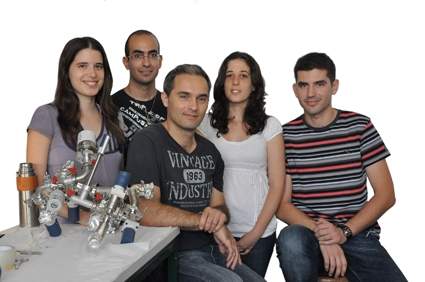Can electronic components be the size of a single molecule? If such molecular components are incorporated into electronic devices, will they function like scaled-down versions of larger materials, or will they have unique properties that could be applied to create entirely new types of systems?
Dr. Oren Tal, who is currently setting up a new lab in the Chemical Physics Department of the Faculty of Chemistry believes that the best way to answer these questions is to look at the very basic issues
_ how electrons move through molecules, for instance. “We’re interested in the basic principles – why it works and how it works. This kind of deeper understanding could lead to technological leaps in the future, and we might learn something new about our world in the process.”
To investigate molecules, Tal must first catch them. He releases the molecules inside a vacuum chamber whose interior is cooled to a chilly 4° above absolute zero. His molecule trap consists of a wire mounted on a piece of springy material. When the material is pushed up from below, the wire bends and breaks apart in a pre-weakened spot, opening up just enough for a single molecule to slip inside. With ultra-sensitive instruments that record the minuscule vibrations taking place in a single molecule, he can tell whether one has fallen into the trap and probe what happens to it when electrons pass through.
Different Disciplines, Same Subject Dr. Oren Tal grew up on Moshav Ramot Hashavim, in central Israel. After completing an M.Sc. in chemistry at the Weizmann Institute, he received his Ph.D. from the Electronics Engineering Department of Tel Aviv University in the field of physical electronics. In his postdoctoral work, in the Physics Department of Leiden University, the Netherlands, Tal began capturing single molecules to investigate their electrical properties. “I studied in three different places, with three different disciplines: chemistry, engineering and physics; but my basic subject matter – conductivity in molecules – has been the same since the beginning,” he says. Tal is married and the father of Jonathan, aged 3, and Lia, aged 1. His interests include Aikido and art. |
In effect, the trapped molecule becomes part of an electronic circuit consisting of the molecule itself and the two pieces of the wire. How does the molecule affect the electrons’ flow? Can it change its properties or the properties of the circuit? Because the molecules in Tal’s experiments stick directly to the sides of the wire, he can pull on them, stretching the molecular bridges to see how this affects their conductivity. In his postdoctoral research, Tal started with the simplest molecules possible: hydrogen and water. He has now moved on to oligoacenes _ molecules in which benzene is a repeating unit. The most basic member in this family, benzene, is a ring containing six carbon atoms. The benzene molecule tends to slip into the trap disk-wise; but it gets tilted when pulled, so that it only touches the wire at two points on the ring. This movement changes the molecule’s conductivity, something like flipping a switch.
What makes a molecular bridge more or less conductive? That is, what determines how electrons pass through? Each molecular bridge restricts its electron flow to a limited number of channels. And because two electrons can’t be in the same state at the same time, if an electron is transmitted via a channel, a second electron cannot use that channel and will be rejected. Tal uses a method of identifying those channels by “listening for noise” – the signals from the electrons that bounce back from already-occupied channels.
Other research that Tal is planning to conduct in his Weizmann lab involves the new field of spintronics. This area is based on using electrons’ spin rather than the electrons’ charge that powers all conventional electronics. Electronic spin exists in one of two orientations, which are referred to as "up" and "down." Spintronic devices might be far more energy-efficient than today’s electronics and much faster, to boot. But scientists must first figure out how to manipulate and preserve electronic spin states in a controlled way. Tal intends to capture molecules with interesting shapes for these experiments: for example, molecules that twist into screw-like shapes. He thinks that movement in their spiral-shaped channels could favor the transmission of spins with a particular orientation.
Dr. Oren Tal's research is supported by the Carolito Stiftung and the estate of Lela London. Dr. Tal is the incumbent of the Alvin and Gertrude Levine Career Development Chair.
